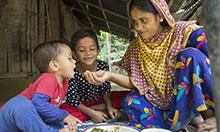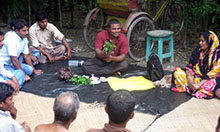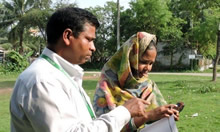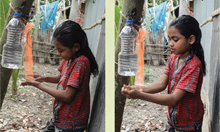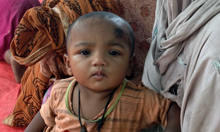Sustainability of Improved Practices Following Graduation
Introduction, Objectives, and Methods
SPRING/Bangladesh is a seven-year USAID-funded project focused on the 1,000-days approach, promoting Essential Nutrition Actions and Essential Hygiene Actions (ENA/EHA) by pregnant and lactating women (PLW) and children under two years of age. We have worked in Bangladesh since 2012, using a multichannel, integrated approach for reducing malnutrition in 40 upazilas of two divisions (Barisal and Khulna) along the country’s coastal belt and employing both nutrition-specific and nutrition-sensitive interventions. With ENA/EHA as our technical foundation, we have developed a variety of interventions based on existing evidence-based approaches to tackle malnutrition, with a particular focus on the first 1,000 days of life. SPRING targeted PLW and their children as the primary audience, though we have also worked with husbands and other family and community members.
We used multiple delivery channels for this work, including the SPRING-led farmer nutrition schools (FNS) activity, as well as training partnerships with government health agents, agricultural extension agents, and development partner facilitators. Farmer nutrition schools are a nine-month training activity that incorporates the advancement and support of the ENA and EHA into food production training modules on vegetable gardening, poultry rearing, and fish production.
To better understand which behaviors were changing and which behavior changes were sustained following the end of the direct FNS intervention, SPRING undertook a mixed-methods cohort study, following a group of FNS participating women over time. Our main objectives were to determine the degree to which women in FNS adopted high-impact nutrition practices by the end of the nine-month FNS period, as well as the extent to which participants sustained these practices during the year following graduation from the FNS. Secondarily, we examined the extent to which attendance played a role in the adoption of FNS recommended behaviors. To answer these questions, we used quantitative and qualitative research techniques.
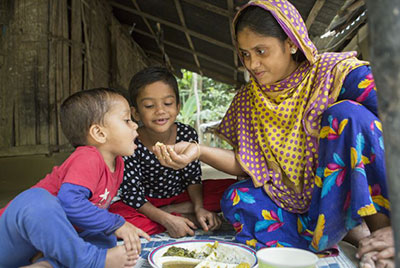
For the quantitative study, we collected data from a cohort of 440 women enrolled in 44 FNS in 38 upazilas and interviewed participant women three times: before beginning the FNS sessions (phase 1), immediately after the FNS sessions were completed (phase 2), and one year after the completion of FNS activities (phase 3). Some households did not contribute data in phase 2 but did provide data in phase 3, resulting in a complete sample of 386 women surveyed in all three phases (i.e., 88 percent of households of phase 1). Data were collected at three points in time: before the FNS training began (November 10–15, 2014), immediately after the training program concluded (July 26–August 2, 2015), and one year after the phase 2 data collection (July 24–31, 2016).
The survey included questions about household sociodemographic characteristics, homestead food production, the consumption of poultry and fish, hygiene practices, dietary diversity of PLW, breastfeeding and complementary feeding practices of infants and young children, and the health and nutrition knowledge of the participants.
For the qualitative study, 24 focus group discussions (FGDs) were conducted, eight each in three distinct locations (in Khulna, Jessore, and Bhola districts). The participants were chosen from among the members of the FNS conducted in fiscal year (FY) 12, FY13, and FY14, based on their availability. Using perceptions of the SPRING field staff, the qualitative study team sought to divide FNS graduates in each area into low and high performers. In both the high- and low-performing groups, we conducted one FGD with the participants of the FY12 FNS, one FGD with the participants of the FY13 FNS, and two FGDs with the recent graduates of the FY14 FNS. Since the goal was to include PLW with children under two who were FNS graduates in the FGDs, and this was also a criterion of FNS membership, the FY13 and FY14 cohorts had more potential participants, due to aging effects. Data were collected directly after the FY14 FNS participants graduated in mid-2015.
Background Characteristics of Respondents
The number of intervention upazilas was higher in Khulna than Barisal, but 53 percent of the samples were from Barisal. Attendance in the FNS sessions was regular and quite high among all participants. Only 13 percent of respondents attended fewer than 75 percent of all sessions. Attendance in specific sessions on gardening or poultry rearing or fish culture was similar. More than 80 percent of respondents participated in more than two-thirds of the sessions.
The education level in the cohort sample was similar to the education levels among mothers as measured in Food Security and Nutrition Surveillance Project (FSNSP) 2014, both nationally and comparing the two divisions included in SPRING. However, in the cohort sample, fewer women were in the least and most educated categories compared to the FSNSP sample (FSNSP national—no education, 18 percent; postsecondary school certificate, 7 percent). The proportion of women who completed partial secondary education was significantly higher in Khulna (50 percent) than in Barisal (37 percent).
Level of Awareness on Nutrition-Related Issues
Most women, over 80 percent, could correctly name nutrient-rich foods before the FNS began, and the proportion increased to a nearly universal correct response by phase 2. As in other cases, the phase 1 knowledge level was greater in Khulna than in Barisal, and in both regions even women who had lower levels of attendance could answer the questions correctly in later phases.
The proportion of women who had knowledge about the importance of putting the child to the breast after birth increased markedly, from 53 percent before training to 83 percent in phase 2 and 89 percent in phase 3. “Colostrum or breastmilk should be the first food for infants” was well-known to the women surveyed. Before the intervention started, the level of knowledge was over 80 percent; this increased to almost 100 percent in phases 2 and 3. Before attending the FNS, more than two-thirds (71 percent) of respondents could correctly report the time at which exclusive breastfeeding should end, and at the end of the FNS training, the proportion of women with correct responses rose to 100 percent, a statistically significant increase.
Seventy percent of women could state a way to prevent anemia before the FNS began; this increased to almost 100 percent by the second phase. A woman who correctly mentioned at least one health problem or disease caused by an iodine deficiency was considered to have appropriate knowledge. This question, by far, had the lowest proportion of women who knew the correct answer during phase 1, at merely 20 percent. This increased to nearly 75 percent by the end of the FNS and continued to increase to nearly 90 percent by phase 3.
Water, Sanitation, and Hygiene
As far as handwashing practices are concerned, the proportion of households using a pond or no “pouring device” fell greatly between phases 1 and 2, before increasing slightly between phases 2 and 3 overall. Most of the households used a tippy tap as their main handwashing station during phase 2 (70 percent), but this share fell to 39 percent by phase 3, with many households again using tube wells or buckets with dippers as the main handwashing source.
Though tippy taps did not remain the main handwashing device for many households one year after the FNS sessions, they were still commonly found in households as a secondary device. At the start of the project, tippy taps were not found in any surveyed households, but 90 percent of households had set up at least one tippy tap by the end of the FNS sessions. One year after the FNS sessions ended, two-thirds of households still had a tippy tap device at their household.
Handwashing practices improved drastically after the end of the FNS and, in phases 2 and 3, a significantly greater proportion of women washed hands at critical junctures (Figure 1).1 Overall, one year after the completion of the FNS sessions, the rates of reported handwashing remained high, but were slightly lower than in phase 2. A similar pattern was seen in both divisions; however, the decline in handwashing practices was seen only in Khulna, while handwashing continued to rise in Barisal.
Figure 1: Proportion of Women Who Reported Washing Hands at a Critical Juncture Using Soap and Water
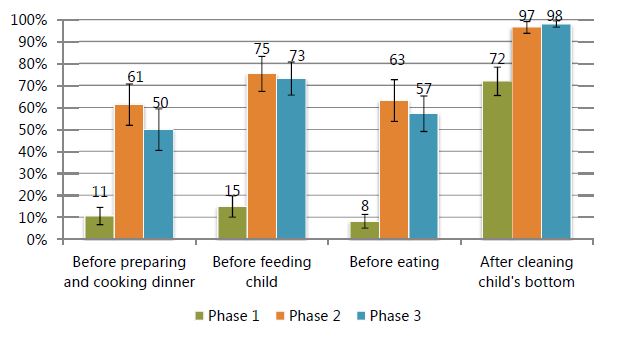
Vegetable Gardening
Growing vegetables at the homestead level is the first production topic covered in the FNS sessions. While a large proportion of households, slightly over 40 percent, were doing some type of gardening at the start of the FNS, this increased to 95 percent by the end of the FNS sessions. In addition, the new gardening households managed to maintain many vegetables growing in phases 2 and 3. The variety of vegetables produced nearly quadrupled during this time and only declined slightly between phases 2 and 3. Similarly, in phase 3 a higher number of households maintained a garden and grew a greater number of vegetable types.
Poultry Rearing
A household was considered to be rearing poultry if they were currently rearing either chickens or ducks or both at the time of the survey. Three-fourths of women surveyed were rearing poultry before attending the FNS, an activity that is very common in the rural context of Bangladesh. During phase 1, on average, households were rearing fewer than eight birds, but by the end of the FNS this figure had increased more than 150 percent, to 12 birds. Even after the FNS sessions concluded, the number of birds reared continued to increase, rising to 13 per household. Households who attended a greater number of FNS sessions also continued to increase the number of birds being kept in the year following the FNS.
Households not only reared more poultry; they also used improved techniques. While only 8 percent of households had their poultry vaccinated in the last three months before the FNS sessions started, this share increased to nearly 60 percent of households by the end of the FNS sessions and remained high, at around one-half of households one year after the FNS sessions had concluded.
Fish Culture
SPRING provided training and guidelines to improve fish culture techniques through its FNS sessions. Overall, the proportion of households cultivating fish in a pond increased significantly, from 48 percent in phase 1 to 67 percent in phase 2, before declining slightly again, to 63 percent in phase 3. FNS households also changed the varieties of fishes they were rearing. Among those households already rearing fish, all reared carp in all three phases. The proportion of households rearing small indigenous fish and tilapia, however, increased faster, from 12 percent to 34 percent.
Dietary Diversity of Women
The measure of dietary diversity used in this study was derived by clustering the 17 questionnaire food types into a nine-item scale. There were notable increases in the proportion of women eating many of these food groups, particularly food groups linked to the FNS program, between phase 1 and phases 2 and 3. Dietary diversity, the sum of the food groups consumed, is a proxy for dietary sufficiency and a measure of diet quality. Before the FNS sessions began, only 32 percent of the surveyed women consumed foods from five food groups or more, which is the benchmark for dietary adequacy. In phases 2 and 3, SPRING found that 72 percent and 61 percent of women, respectively, were consuming foods from five food groups or more, a significant improvement over phase 1 (Figure 2). The mean dietary diversity score was low, at 3.9, before women started the FNS sessions. This score increased to 6.0 immediately after the end of the 18 FNS sessions. One year after the closing of the FNS sessions, the mean dietary diversity score remained high, at 5.6.
Figure 2: Dietary Diversity Score of Women
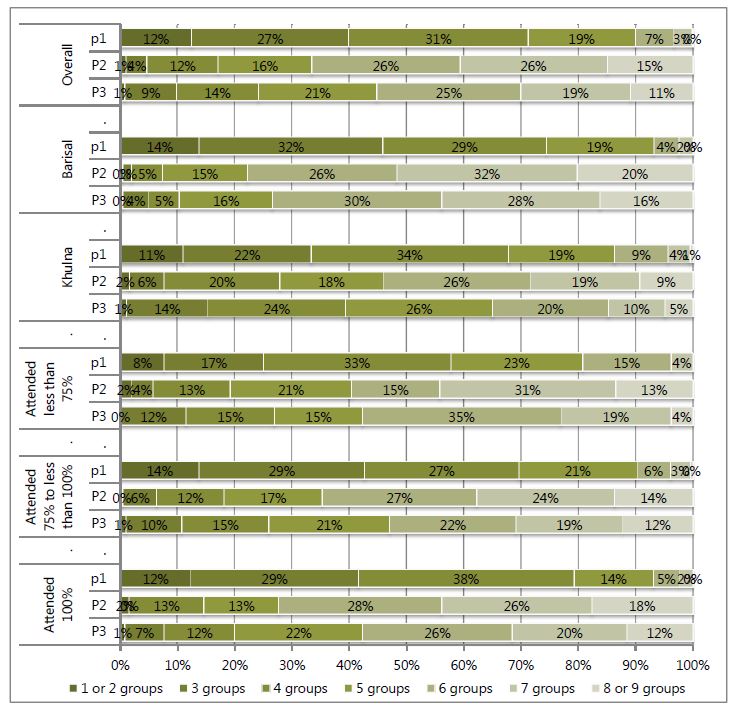
Contribution of Women in Household Income
In this study, as in the FSNSP system, involvement in an income-earning occupation is defined as any activity that results in household income, even if that income is not received by the same individual performing the activity. The proportion of women currently involved in income-earning activities increased significantly, from 12 percent involvement in phase 1 to 27 and 53 percent involvement in phases 2 and 3 respectively. Similarly, the proportion of women earning income was similar in Khulna and Barisal in phase 1, but increased more rapidly and to a higher level during both phases 2 and 3 in Khulna than in Barisal, though the difference was not significant.
Discussion/Conclusion
The clear majority of FNS participants did not miss not more than three of the 18 FNS sessions. For some of the variables, more participation in FNS sessions contributed to achieving better results. There was a positive contribution of FNS in increasing the early breastfeeding behavior among the mothers. The changes between the phases were statistically significant. There was a significant drop in using tippy taps between phases 2 and 3. Further analysis is required to better understand the reasons for this decrease.
The positive trend in terms of the increased proportion of women engaged in income-earning activities could have been driven by the SPRING program in one of two ways: 1) SPRING directly supported and encouraged women to undertake greater production of food at the homestead level and to sell any surplus production; or 2) direct training enabled women to realize their contribution to household income through savings and other factors around empowerment.
The qualitative findings of the study were consistent with the quantitative findings discussed above. This part of the study identified that many aspects of SPRING’s FNS work played an important role in improving the ability of poor women to provide nutritious food and proper nutrition to their children as well as their families. It is clear, through their FGD responses, that FNS participants are continuing the practices they learned from the FNS sessions, including homestead gardening, poultry rearing, handwashing, and nutrition practices, and that the techniques and lessons learned from the FNS have helped change the way they handle food, nutrition, and hygiene in their homes. This was true among both the high- and low-performing groups. Fish farming was practiced by fewer participants than other food production components, due to practical constraints such as geographical location and availability of resources. Despite these barriers, however, most FNS participants tried to carry out all the practices as much as possible, and important signs of buy-in, sustained behavior change, and even spillover can be seen in the FGD findings.
In summary, our mixed-methods cohort study clearly showed that women who participated in the 18 FNS sessions not only greatly increased their knowledge and practices, but also, for the clear majority of practices, sustained them one year after the end of the program. The qualitative work further supports the quantitative findings and provides insights into how and why FNS participants are choosing to undertake certain activities and how they can continue these. Although participants mentioned some barriers, these did not appear to be insurmountable and were for the most part managed through support from family and community members.
Strengths and Limitations
This study benefits from a relatively large sample spread across more than 40 sites. The consistent elements of the survey, the panel design, a stable survey instrument, and the fact that many of the data collectors remained the same in all phases of the survey, increases the power of the comparisons made across time and space. The survey instrument sought to cover all the major elements taught in the FNS modules. The timing of the study was also ideal, with phase 1 implemented before any FNS sessions began.
Special attention was given to data collection, data management, and analysis. Before data collection began, the enumerators for the study were given a week-long training and sufficient oversight was provided to all teams in the field. Data management was undertaken starting with the original data, and all data cleaning steps are documented and reproducible. During analysis, care was taken to account for the clustering in the data and to ensure that the analysis was done over a consistent population in each period.
The study design also had some limitations. Most notably, the study does not contain a comparison group, so we cannot verify that the changes observed within the sample are attributable to the SPRING program. Additionally, the seasonal variation observed between phases 1 and 2 could have resulted in some of the observed change, especially as vitamin A–rich fruits are much more readily available during the monsoon months, when data for phases 2 and 3 were collected. Another limitation is our inability to say much about changes in child diets due to the aging in the child sample across the phases of data collection. This study may also suffer from some level of social desirability bias, as FNS participants could have reported positive results to obtain approval from the project and the field-workers. Most responses recorded during the survey were self-reported.
Footnotes
1 Critical junctures refer to key times when FNS participants are encouraged to wash their hands. These times include after changing a baby’s diaper, before cooking, after using the latrine, before eating, after handling or being in contact with animals, and before feeding a child.
